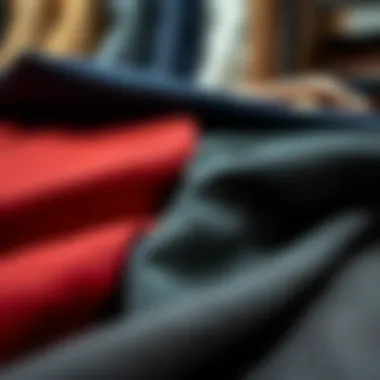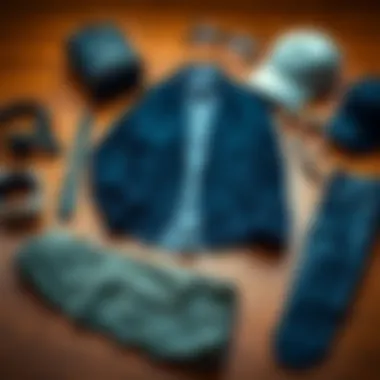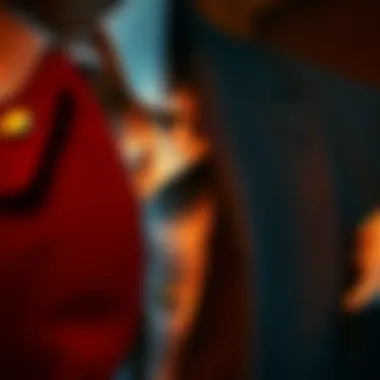Men's Clothing: A Comprehensive Guide to Style


Intro
The world of men's clothing is not just about covering the body; it's a vibrant tapestry woven with strands of culture, individuality, and social dynamics. Each piece of clothing tells a story, reflecting the evolution of style, fabric innovations, and the ideologies of an era. To truly grasp the nuances, one must embark on a journey that delves deeper into the layers of fabric, design, and identity.
This guide seeks to unravel the complexity of men's fashion, discussing the trends that shape contemporary masculinity, the significance of fit, and the essential wardrobe staples a man should possess. In a landscape where sustainability is paramount, it also encourages a mindful approach to fashion choices. Whether you're a trendy enthusiast or someone looking to upgrade their wardrobe, there's something here for everyone, ensuring you step out with confidence and style.
With that foundation set, let's dive into the latest fashion trends.
Preamble to Men's Clothing
Men's clothing is more than just garments; it embodies individual expression, cultural identity, and societal norms. The world of men’s fashion has evolved significantly, reflecting not only personal style but also broader societal changes. Understanding men's clothing can help readers navigate this complex landscape, making informed choices that resonate with their individuality.
Historical Context
To truly grasp the essence of today's men's fashion, we must first rewind the clock. The historical context of men's clothing showcases how styles have transformed through ages, often driven by various factors such as functionality, societal roles, and even politics.
In the medieval era, for example, clothing often indicated class and status. Wealthy gentlemen adorned themselves in vibrant colors and luxurious fabrics, while commoners wore humble, rough-spun attire. Fast forward to the industrial revolution, and clothing began to shift towards practicality due to urban living and the rise of the working class. The 20th century ushered in radical changes, with the emergence of youth culture and counter-culture movements influencing fashion trends dramatically. Today, we see a blend of these historical influences melding into contemporary styles, where the influence of streetwear is palpable alongside luxury brands.
Significance of Attire in Society
Men's clothing serves as a mirror, reflecting social norms, values, and identity. The significance of attire goes beyond the aesthetic; it plays a crucial role in how individuals perceive and are perceived by others.
In different situations, the choice of clothing sends subtle signals about one’s personality and status. For instance, attending a formal event in a tailored suit can convey professionalism and respect, while casual wear at a social gathering may signal comfort and approachability. Moreover, clothing can empower individuals, instilling a sense of confidence.
"Dressing well is a form of good manners." - Tom Ford
Exploring the significance of attire opens up discussions about the non-verbal communication of fashion. It shapes interactions, influences opinions, and constructs identities within society.
This understanding is vital for anyone navigating the landscape of men's clothing. By grasping its historical roots and societal importance, one can make more thoughtful choices that align with their personal ethos and societal expectations.
Core Elements of Men's Fashion
Men's fashion is more than just a collection of clothes; it’s an intricate tapestry woven from personal preference, societal norms, and historical influences. The core elements of men’s fashion intertwine to create a unique style narrative representing individual identity, lifestyle choices, and cultural history. Understanding these components is essential for anyone looking to navigate the sartorial landscape successfully.
Understanding Fit
When it comes to clothing, fit is king. The right fit enhances a man's physique and boost confidence. Conversely, underestimating fit can lead to an appearance that's quite the opposite—ill-fitted clothes can mask a good outfit, making even the most expensive garments look drab. Consider a tailored blazer that hugs the shoulders just right; it makes a statement. It’s crucial to keep in mind that everyone has different body shapes, so what works for one might not work for another.
Fit can generally be categorized as:
- Relaxed Fit: Comfortable and loose, ideal for casual settings.
- Regular Fit: Balanced in dimensions; flattering for most body types.
- Slim Fit: Sleeker and more fitted, this cut gives a modern edge.
The idea here is to understand one’s body type and customize clothing choices accordingly, leading to an ensemble that feels good and looks great.
Fabric Varieties and Selections
Fabric forms the foundation of every outfit. It's essential to know the different fabric types to make informed decisions that contribute to style and comfort.
Natural Fabrics
Natural fabrics, such as cotton, wool, and linen, offer breathability and comfort unlike any synthetic counterpart. One of the standout features of natural fabrics is their ability to regulate temperature; for example, linen is cool in summer, while wool provides warmth in winter. Furthermore, natural materials are often biodegradable, making them preferable for the eco-conscious consumer.
However, it’s important to note that these fabrics can be prone to wrinkles and wear over time. For instance, while cotton is soft and breathable, it can lose its shape with frequent washing. Still, their natural allure makes them a staple in any wardrobe.
Synthetic Materials
On the flip side, synthetic materials like polyester and nylon offer durability and resistance to wear and tear. These fabrics tend to be wrinkle-free and maintain their shape, making them practical choices for everyday wear. The rapid drying capability of synthetic fibers can be beneficial for athletic and activewear, especially when comfort and utility are top concerns.


Yet, synthetic fabrics have their downsides. They are often less breathable than natural options, which can lead to discomfort in hot weather. Moreover, their environmental impact is a growing concern due to the plastic fibers that may contribute to pollution.
Blends and Their Applications
Blends, which mix natural and synthetic fibers, can offer the best of both worlds. A blend combining cotton and polyester is a prime example; it feels soft against the skin but boasts the durability of synthetic fibers. This fusion enhances functionality while retaining a polished look.
The versatility of blends allows them to adapt to various needs—whether it's for work, leisure, or formal occasions. However, while blends tend to be more durable, they may not offer the same breathability as pure natural fabrics, making it essential to choose blends wisely based on the intended use.
Color Theory in Men's Clothing
Color serves as a powerful tool in fashion. It can affect perceptions, create moods, and express identities. Neutral colors are often seen as foundational, providing a canvas for splashes of color, while bold shades can make a statement or reflect a personality. Understanding color theory involves grasping the basics of the color wheel; for example, complementary colors can help create eye-catching contrasts. Furthermore, seasonal color trends can guide choices based on what’s in vogue, making an awareness of color both beneficial and strategic.
In summary, the core elements of men's fashion explore the intricate balance of fit, fabric, and color, each contributing to a man's overall look and attitude. Invest time in learning and adapting these elements to express individuality while still adhering to contemporary style standards.
Categories of Men's Clothing
Understanding the landscape of men's clothing involves not only knowing the various styles available but also how they interplay with personal identity, social context, and even environmental awareness. This section covers the various categories of men’s clothing, which serve as the framework for navigating personal style choices. Each category speaks to different aspects of life: informal settings, professional environments, or fitness activities. Herein lies its significance, as structure creates clarity—clarity turns into informed choices that express individual taste and practicality.
Casual Wear
Casual wear encompasses a more relaxed approach to clothing, bridging the gap between comfort and style. It's what you might reach for on a Sunday brunch date or a casual Friday at the office. The important aspect of casual wear is versatility; it allows expression without compromising ease and comfort. Let's delve into specific components.
T-Shirts and Polos
T-shirts and polos are foundational staples in any man's wardrobe. Their key characteristic lies in their adaptability. A simple white T-shirt can be dressed up with a blazer or dressed down with swim shorts. Durability and comfort make them a smart choice, especially during warm weather.
What sets these garments apart is their fabric. For instance, a cotton tee breathes well, while a polyester blend might resist wrinkling and hold color longer. This duality presents both advantages and disadvantages; while cotton offers softness, it may wear out faster compared to synthetic blends. Ultimately, the choice hinges on the occasion and personal preference.
Jeans and Chinos
When it comes to pants, jeans and chinos serve different aesthetic and functional purposes but are equally valued. The unique feature of jeans is their ruggedness and timeless appeal, generally signifying casual chic. Chinos, on the other hand, bring a polished yet comfortable approach, suitable for situations where one desires to look sharp without being overly formal.
Their beneficial nature is in how they fit into various scenarios—from a barbecue to a casual Friday meeting. However, jeans can sometimes clash with certain social settings while chinos are often seen as best suiting professional environments. Adjusting your choice based on the event can strongly influence the message that your outfit communicates.
Footwear Options
Footwear can make or break an outfit, and casual options are no exception. Sneakers, loafers, and casual boots all bring a unique flavor to casual wear. The key characteristic here is comfort combined with style; these shoes can transform an outfit from basic to statement.
Distinct features are significant as well. For instance, high-tops might give a sporty vibe, while loafers could convey a laid-back sophistication. However, finding the right footwear requires attention to detail, ensuring that it matches both the outfit and the occasion. On the downside, some options, while fashionable, may not provide the same comfort level as others. So, investigating the right balance between aesthetics and comfort is crucial.
Formal Attire
When casual wear won't suffice, formal attire plays a pivotal role in creating an impression, especially in business or ceremonial settings. Formal clothes demand attention to detail, fabric, and fit to convey the right message. The elegance of formal wear signifies professionalism, respect, and attention—important traits in today’s world.
Suit Styles and Cuts
Suit styles range significantly, from classic silhouettes to modern fitted cuts, catering to various body types and tastes. Key characteristics include lapel styles, button placements, and tailored fits, all of which create a distinct look. A fitted suit can enhance a man's posture and confidence, making him stand taller in any social setting.
The unique feature here is customization; a bespoke suit embodies personal expression, allowing for fabric choice and fit adjustments. However, off-the-rack suits can sometimes compromise on fit. Careful consideration must be given to the intended use—whether it’s for interviews or weddings, the “look” must align with the occasion and personal style.
Shirts and Ties
A well-chosen shirt and tie combo can elevate formal attire instantly. Key characteristics of shirts range from fabric types like cotton to blends that offer stretch. They can show individuality, depending on color choices and patterns.
Ties, often seen as accessories, serve a functional purpose—they can change the whole vibe of an outfit. While slim ties lend a modern touch, wider styles might project a more classic aesthetic. Understanding the advantages of these combinations allows men to suit up smartly for any formal scenario.
Footwear for Formal Events
Shoes seem to be the unsung heroes of formal wear, unexpectedly playing a role in overall appearance. Dress shoes, including Oxfords, brogues, and loafers, are typically expected in more formal settings. Key characteristics include shine and texture; they can impress or detract.


These formal options come with unique features, such as leather quality and craftsmanship. For instance, handmade shoes might cost more but often offer superior comfort and style. As with any formal attire, the right shoes will tie the look together, but wearing impractical footwear can lead to an uncomfortable experience, especially in long events or gatherings.
Athletic and Activewear
As lifestyles become increasingly health-conscious, athletic and activewear emerge as fundamental categories. They blend comfort with performance, serving various needs—from lifting weights to Friday night basketball. This clothing isn’t only for working out; it integrates into leisure and daily life, promoting versatility.
Functional Fabrics
In the realm of activewear, functional fabrics take center stage. These fabrics are engineered to wick moisture and provide breathability, making them essential for physical activities. Their key characteristic is their performance-driven nature, allowing wearers to train harder without overheating.
Materials like spandex, polyester, and nylon lend to this category. This unique feature makes activewear versatile, transitioning easily from workout to casual outings. However, while they excel in functionality, some may lack the aesthetic appeal of more traditional fabrics, which can set them apart in various social situations.
Fit and Performance
Fit is paramount in athletic gear. Gear that fits correctly can enhance performance and prevent injury. The key characteristic here is the emphasis on movement and comfort, with many brands offering items designed specifically for certain activities.
Notably, performance-enhancing features like compression technology may also play a significant role in muscle support. However, zones of flexibility must be balanced with aesthetics; overly technical designs can deter casual wearers from choosing performance wear for day-to-day activities.
Layering Techniques
Understanding layering is also fundamental. The key characteristic of layering techniques lies in their functional capacity to regulate temperature. For instance, wearing a moisture-wicking base layer under a breathable mid-layer serves to trap heat as well as wick away sweat.
The unique advantage of layering makes it adaptable; one's outfit can shift effortlessly from chilly mornings to warmer afternoons. But the downside is that learning to layer effectively does take a bit of practice and strategy to ensure a polished look. Striking the right balance ensures style resonates with utilitarian aspects.
By understanding clothing categories, one can make informed choices irrespective of setting, occasion, or personal style needs.
Navigating Style Trends
In the ever-evolving landscape of men’s fashion, navigating style trends serves as a significant compass for individuals seeking to express their identity through clothing. Understanding these trends not only enables one to stay current but also provides a framework for intentional choices in attire. By following emerging styles, men can effectively convey a sense of relevance while also exploring facets of personal expression. Additionally, recognizing and adapting to trends can enhance one’s wardrobe longevity, aiding in the selection of versatile pieces that hold both style and substance.
Current Fashion Trends
Trends in men's fashion can shift faster than the seasons change. In recent years, several styles have carved their niche, influencing everyday wear. For instance, the rise of athleisure has redefined casual wear by seamlessly blending functionality with fashion. Joggers and stylish sneakers have transitioned from gym essentials to day-to-day staples. On the other hand, oversized silhouettes are gaining traction, often paired with more fitted pieces for balance. This juxtaposition holds appeal for those who seek comfort without compromising on style.
Furthermore, tailored garments have made a resurgence, particularly in the realm of suits. Modern interpretations include relaxed cuts and softer fabrics, allowing for versatility in both professional and casual settings. The push towards sustainable fashion also shapes current trends, with brands emphasizing eco-friendly materials and ethical production processes. Staying abreast of these shifts not only enriches one’s wardrobe but also empowers men to make informed purchasing decisions that reflect their values.
Cultural Influences on Fashion
Cultural factors wield remarkable influence over fashion trends, often acting as a mirror of societal changes. The intersection of music, art, and personal identity plays a crucial role in shaping what becomes fashionable. Take, for example, hip-hop culture; it has undeniably impacted men's dress codes, promoting everything from streetwear to luxury collaborations. Artists like Kanye West and Pharrell Williams blend their musical influence with distinct fashion lines, enticing audiences to embrace styles rooted in cultural narratives.
Moreover, globalization brings a mélange of influences to the forefront, as styles from various regions interact more than ever. What was once local fashion can now easily become a global trend overnight. For instance, the growing popularity of Japanese streetwear reflects a shift towards unique expressionism in men’s clothing, inviting patrons to display individuality. Similarly, traditional fabrics from Africa, like Ankara prints, are reimagined in contemporary designs, enriching the global fashion narrative.
Ultimately, navigating cultural influences allows men to appreciate the diverse origins of their attire while choosing pieces that resonate with their personal story. As men consciously engage with these cultural shifts, they participate in a broader dialogue that shapes the future of clothing—a powerful way to make a statement without uttering a word.
Fashion is not just about clothes; it's a reflection of one's journey, identity, and cultural backdrop.
Accessorizing for Impact
Accessorizing plays a crucial role in defining a man’s style and enhancing the overall impact of an outfit. It’s not merely about adding a few items here and there; it’s about strategically selecting pieces that convey personality, sophistication, and confidence. Accessories are often the unsung heroes of fashion, capable of transforming even the most basic outfits into something memorable. They allow for self-expression and can bring forth a unique touch, making every look distinctly yours. Moreover, accessories can provide practical benefits—from functionality to comfort—while maintaining a fashionable edge.
Essential Accessories
Watches
A watch serves as more than just a tool for keeping track of time. It's a statement piece reflecting one’s style, status, and even profession. The key characteristic of a good watch lies in its versatility. Whether it’s a sleek dress watch for formal occasions or a rugged sports watch for outdoor adventures, there’s something for each scenario. Watches can elevate an outfit from mundane to remarkable, adding a layer of sophistication.
Unique features, like intricate chronographs or unique material compositions, can turn a simple wristwatch into a conversation starter. For instance, a classic leather-band watch offers charm and timeless elegance, while a high-tech smartwatch introduces functionality fit for contemporary lifestyles. However, it’s vital to consider the potential downsides: some may find the bulk of certain models uncomfortable or impractical for daily wear.


Bags
When it comes to bags, the contribution to personal attire is substantial. A well-chosen bag not only serves a practical purpose—carrying essentials—but also acts as a fashion accessory that completes a look. The key characteristic of bags is their variety. From sleek messenger bags for business to casual totes for leisurely outings, the options are as diverse as the settings they suit.
The unique feature of a bag may also involve materials and craftsmanship. Leather bags, for example, often project a sense of rugged sophistication, while canvas bags might showcase a more relaxed and practical style. One consideration in choosing bags is size and functionality—though larger bags can be practical, they might clash with the attire for more formal settings. Therefore, balance is key.
Belts
Belts serve not only a functional role but also a stylistic one. A well-fitting belt adds a polished finish to any outfit. The primary characteristic that stands out is the variety of materials and styles available. Whether it’s a classic leather belt, a casual woven style, or a reversible design for versatility, the right belt can complement different outfits seamlessly.
Uniquely, belts also allow for craftsmanship to shine through. Handcrafted leather belts might feature intricate stitching or personalized buckles, making them special. However, it’s important to avoid overly ornate designs that can overshadow the rest of your outfit. A functional yet stylish belt is essential for creating a cohesive aesthetic.
Layering Accessories
Layering accessories is an art that can truly showcase one’s sense of style. It's about balancing various elements to create depth without overwhelming an outfit. From scarves draped across coats to hats that add flair, the possibilities abound. For instance, a simple t-shirt can become striking when layered with a well-structured jacket and topped off with a distinctive scarf.
Incorporating various textures and patterns via layering accessories allows an individual to display creativity and confidence. Attention to detail becomes paramount; for example, ensuring that colors complement rather than clash maintains a harmonious look. Ultimately, layering accessories must be thoughtfully curated to enhance rather than complicate one's style.
Sustainable Fashion Choices
In today's world, the fashion industry faces scrutiny for its environmental impact. This has given rise to the concept of sustainable fashion, which prioritizes practices that lessen ecological damage while promoting social responsibility. Sustainable fashion choices aren't merely a fleeting trend; they symbolize a commitment to a healthier planet and ethical labor practices.
The notion of sustainability in fashion encompasses various aspects, including how garments are produced, the materials used, and the longevity of the items bought. Understanding the importance of these choices can empower consumers to make decisions that align with their values and contribute to a more sustainable future.
Ethical Brands and Their Impact
Ethical brands play a crucial role in changing the landscape of men's clothing. These brands prioritize transparency and integrity in their production processes, often championing labor rights and fair wages. By choosing to support such brands, consumers not only invest in high-quality products but also contribute to a larger cause.
- Transparency: Many ethical brands openly share their sourcing methods, providing consumers with insight into where and how their clothes are made.
- Quality over Quantity: These companies often focus on creating well-crafted apparel designed to last, discouraging the throwaway culture prevalent in fast fashion.
- Local Production: Supporting local artisans and production can minimize carbon footprints associated with long-distance shipping.
Brands like Patagonia, Everlane, and Reformation exemplify how ethical practices can be seamlessly integrated into attractive, stylish designs.
"Choosing to invest in ethical brands fosters a direct relationship between consumers and the source of their products, encouraging a conscious approach to purchasing."
Recycling and Upcycling
Recycling and upcycling are pivotal elements within the sustainable fashion framework. These practices not only reduce waste but also breathe new life into old garments. Recycling involves breaking down fabrics to create new materials, while upcycling takes used clothing and transforms it creatively, often enhancing its value.
- Reduction of Textile Waste: Approximately 92 million tons of textile waste is generated globally each year. Recycling keeps older fabrics out of landfills and encourages a circular economy.
- Creative Expression: Upcycling challenges creativity. For instance, converting old jeans into a stylish tote bag or transforming a vintage t-shirt into a trendy oversized top can personalize fashion choices uniquely.
- Less Resource Intensive: Both processes require considerably fewer resources like water and energy compared to producing new clothing.
Closure: Crafting Your Personal Style
In the realm of men’s clothing, crafting a personal style goes beyond simply wearing clothes. It is an ongoing journey where self-expression meets the pragmatic aspects of dressing. Personal style reflects who you are, often shaped by your experiences, preferences, and even your aspirations. This section will look at the significance of recognizing your individual needs and investing in timeless pieces that will ply a major role in shaping and maintaining your wardrobe.
Assessing Individual Needs
Understanding your requirements in clothing is foundational before embarking on the quest for a unique style. Every man has diverse lifestyles, work environments, and social circles that influence what they wear. For instance, the needs of a corporate professional differ significantly from that of a creative artist.
Here are some critical points to consider:
- Lifestyle Evaluation: Take time to reflect on your daily routine. Are you often on the move or do you spend most time in a office setting?
- Body Type Considerations: Recognizing your body shape plays a vital role in choosing flattering cuts and fits that enhance your appearance.
- Personal Comfort: Each man has a comfort level with regard to fabrics and styles. Some may prefer tailored suits, while others are more at ease in relaxed attire, like oversized shirts and joggers.
By taking these factors into account, you create a wardrobe that works with your life rather than against it.
Investing in Timeless Pieces
Once you’ve established your individual needs, the next step is to focus on what to invest in. Timeless clothing pieces serve as the backbone of any discerning wardrobe, offering versatility and longevity. Investing here could save you money in the long run while ensuring that you always look polished.
Consider these essentials that never go out of style:
- Well-Fitted Suits: A good suit can be the difference between blending in and standing out. Opt for classic colors like navy or charcoal to maximize wearability.
- White Dress Shirts: This item is a chameleon; it can be dressed up or down depending on the circumstance.
- Quality Footwear: Shoes can make or break an ensemble. Investing in a pair of leather oxfords or loafers will serve you well for years.
- Versatile Outerwear: A well-cut blazer or a classic trench coat can elevate almost any outfit.
"Fashion fades; style is eternal." – Yves Saint Laurent
Ultimately, choosing timeless over trendy results in a wardrobe that not only stands the test of time but also reflects maturity in fashion decisions.















